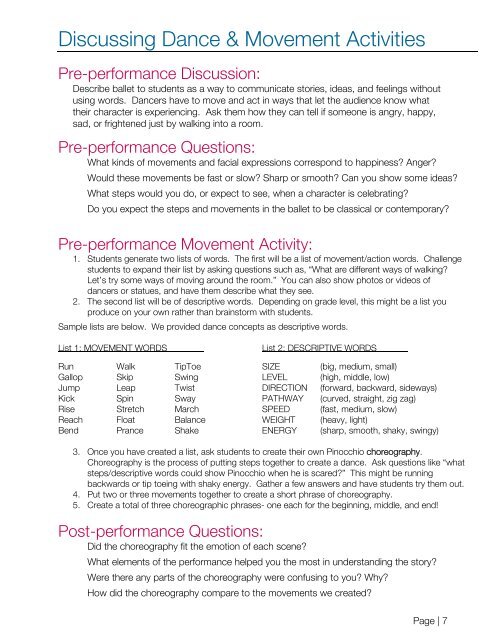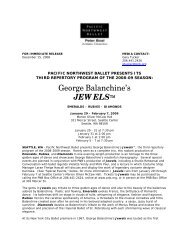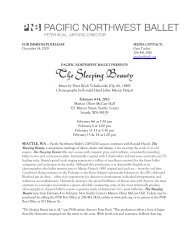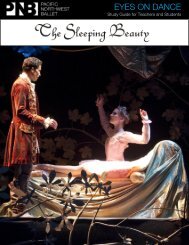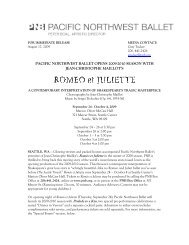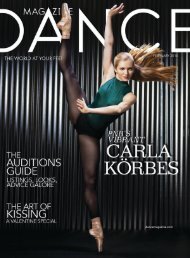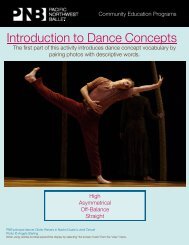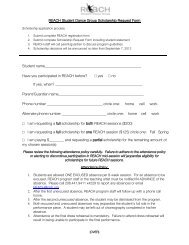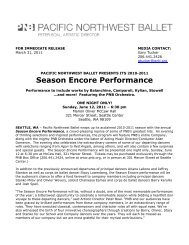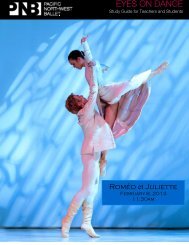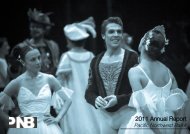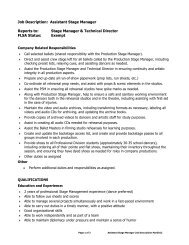You also want an ePaper? Increase the reach of your titles
YUMPU automatically turns print PDFs into web optimized ePapers that Google loves.
Discussing Dance & Movement Activities<br />
Pre-performance Discussion:<br />
Describe ballet to students as a way to communicate stories, ideas, and feelings without<br />
using words. Dancers have to move and act in ways that let the audience know what<br />
their character is experiencing. Ask them how they can tell if someone is angry, happy,<br />
sad, or frightened just by walking into a room.<br />
Pre-performance Questions:<br />
What kinds of movements and facial expressions correspond to happiness Anger<br />
Would these movements be fast or slow Sharp or smooth Can you show some ideas<br />
What steps would you do, or expect to see, when a character is celebrating<br />
Do you expect the steps and movements in the ballet to be classical or contemporary<br />
Pre-performance Movement Activity:<br />
1. Students generate two lists of words. The first will be a list of movement/action words. Challenge<br />
students to expand their list by asking questions such as, “What are different ways of walking<br />
Let’s try some ways of moving around the room.” You can also show photos or videos of<br />
dancers or statues, and have them describe what they see.<br />
2. The second list will be of descriptive words. Depending on grade level, this might be a list you<br />
produce on your own rather than brainstorm with students.<br />
Sample lists are below. We provided dance concepts as descriptive words.<br />
List 1: MOVEMENT WORDS<br />
List 2: DESCRIPTIVE WORDS<br />
Run Walk TipToe SIZE (big, medium, small)<br />
Gallop Skip Swing LEVEL (high, middle, low)<br />
Jump Leap Twist DIRECTION (forward, backward, sideways)<br />
Kick Spin Sway PATHWAY (curved, straight, zig zag)<br />
Rise Stretch March SPEED (fast, medium, slow)<br />
Reach Float Balance WEIGHT (heavy, light)<br />
Bend Prance Shake ENERGY (sharp, smooth, shaky, swingy)<br />
3. Once you have created a list, ask students to create their own <strong>Pinocchio</strong> choreography.<br />
Choreography is the process of putting steps together to create a dance. Ask questions like “what<br />
steps/descriptive words could show <strong>Pinocchio</strong> when he is scared” This might be running<br />
backwards or tip toeing with shaky energy. Gather a few answers and have students try them out.<br />
4. Put two or three movements together to create a short phrase of choreography.<br />
5. Create a total of three choreographic phrases- one each for the beginning, middle, and end!<br />
Post-performance Questions:<br />
Did the choreography fit the emotion of each scene<br />
What elements of the performance helped you the most in understanding the story<br />
Were there any parts of the choreography were confusing to you Why<br />
How did the choreography compare to the movements we created<br />
Page | 7


